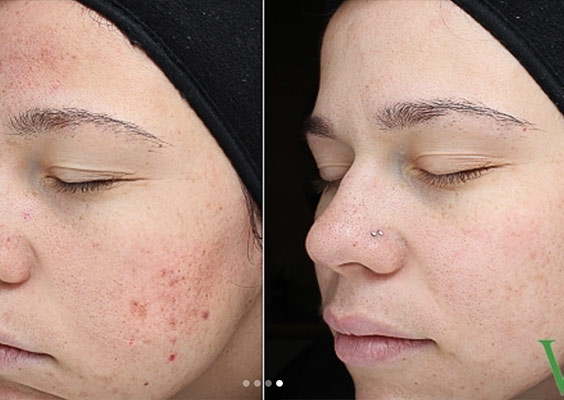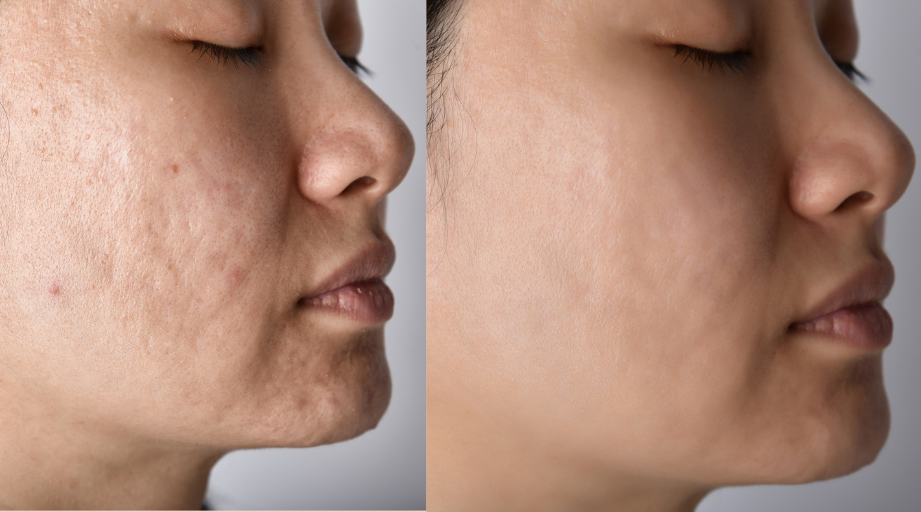
What are the contraindications to subcision?
Subcision may not be suitable in the following circumstances:
- Patients with a history of hypertrophic or keloid scars
- Current or recent (within 12 months) systemic oral retinoid (eg acitretin, isotretinoin)
- Bleeding or blood clotting disorders (coagulopathy)
- Active bacterial or viral infection
Assessment of acne scars
Acne scar severity can be graded using Goodman and Baron’s qualitative acne scar grading system to allow objective pre and post-treatment comparisons.
1. Macular scars
Macular scars can be erythematous, hyperpigmented (brown) or hypopigmented (pale) flat marks. They do not represent a problem of contour like other scar grades but of color.
2. Mild atrophic or hypertrophic scars
Mild atrophic (thin) or hypertrophic (thick) scars may not be obvious at social distances of 50 cm or greater and may be covered adequately by makeup or the normal shadow of shaved beard hair in men or normal body hair if extrafacial.
What is subcision and how does it work?
Subcision is a minor surgical procedure used for treating depressed cutaneous scars and wrinkles. It is also called subcutaneous incisional surgery.
Subcision is performed using a special hypodermic needle inserted through a puncture in the skin surface. The sharp edge of the needle is used to break fibrotic strands that are tethering the scar to the underlying tissue.
The release of the fibrotic strands and new collagen deposition caused by wound healing leads to cosmetic improvement of the scar. Subcision can be safely performed in the outpatient setting and is usually well tolerated.
What are the indications for subcision?
The decision to perform subcision will depend on the type, location, and severity of scarring; patient preference and expectations; and clinician experience and expectations.
Subcision may be used for the treatment of:
- Depressed distensile scars (due to acne, trauma, surgery )
- Depressed bound down scars (due to acne*, varicella (chickenpox), trauma, surgery )
- Depressed skin grafts
- Wrinkles
- Cellulite dimples

How is subcision performed?
The procedure of subcision is described below.
- The area to be treated is cleansed to remove dirt and make-up
- The scar margins may be defined with a surgical marker, adjusting overhead lighting to delineate depressions.
- Local anaesthetic is infiltrated.
- A tri-bevelled needle (number 18 or 20 gauge) or a Nokor needle (fig.3) is inserted at an acute angle adjacent to the scar with the bevel upwards and parallel to the skin surface. Smaller gauge needles (25–27) may be used for small superficial scars and wrinkles.
- The needle is advanced through the dermis and moved back and forth in a fan-like motion. A snapping sound is heard as fibrous bands are transected in the deep dermis and deep dermal subcutaneous plane.*
- The needle is rotated 90 degrees and moved again in a fan-like motion through the dermal scar (fanning subcision).
- The needle is removed and squeezed circumferentially around the exit point to prevent large haematoma formation due to bleeding.
- Manual pressure is applied to the wound for several minutes.
*A common pitfall is to fan too deeply in a plane below the dermis
After the procedure
Immediately after subcision:
- Pressure and ice are applied to the operated site to maintain haemostasis and reduce the risk of bleeding.
- Make-up may be applied to camouflage bruised areas.
- Some authors recommend antibiotics and anti-inflammatory medication.
The number and intensity of subcisions should be limited on the first treatment to review the patient’s response, particularly when treating areas with a predilection for a hypertrophic reaction after subcision.
How many treatments are required?
Individuals vary in their ability to form collagen (scar tissue). The number of subcisions required to correct a depression will depend on the type, location, severity of depression, and intensity of treatment.
Three to six visits suffice for the majority of cases of moderate scarring. Intervals of at least one month in-between treatments are generally recommended.
